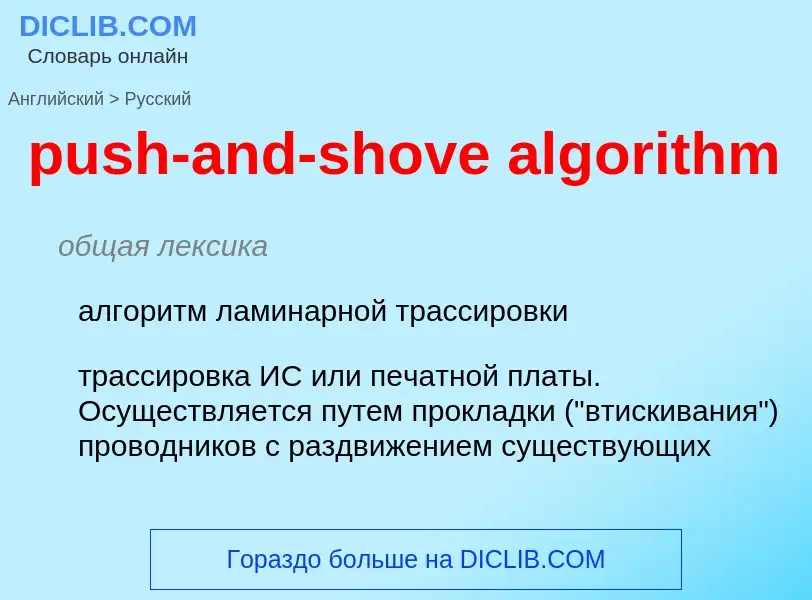Enter a word or phrase in any language 👆
Language:
Translation and analysis of words by artificial intelligence
On this page you can get a detailed analysis of a word or phrase, produced by the best artificial intelligence technology to date:
- how the word is used
- frequency of use
- it is used more often in oral or written speech
- word translation options
- usage examples (several phrases with translation)
- etymology
push-and-shove algorithm - translation to russian
WIKIMEDIA DISAMBIGUATION PAGE
Push Comes to Shove Instrumentals; Push Comes To Shove; Push Comes To Shove Instrumentals; Push Comes to Shove (disambiguation)
push-and-shove algorithm
общая лексика
алгоритм ламинарной трассировки
трассировка ИС или печатной платы. Осуществляется путем прокладки ("втискивания") проводников с раздвижением существующих
algorithm
SEQUENCE OF INSTRUCTIONS TO PERFORM A TASK
Algorithmically; Computer algorithm; Properties of algorithms; Algorithim; Algoritmi de Numero Indorum; Algoritmi de numero indorum; Algoritmi De Numero Indorum; Алгоритм; Algorithem; Software logic; Computer algorithms; Encoding Algorithm; Naive algorithm; Naïve algorithm; Algorithm design; Algorithm segment; Algorithmic problem; Algorythm; Rule set; Continuous algorithm; Algorithms; Software-based; Algorithmic method; Algorhthym; Algorthym; Algorhythms; Formalization of algorithms; Mathematical algorithm; Draft:GE8151 Problem Solving and Python Programming; Computational algorithms; Optimization algorithms; Algorithm classification; History of algorithms; Patented algorithms; Algorithmus
algorithm noun math. алгоритм algorithm validation - проверка правильности алгоритма
algorithmic method
SEQUENCE OF INSTRUCTIONS TO PERFORM A TASK
Algorithmically; Computer algorithm; Properties of algorithms; Algorithim; Algoritmi de Numero Indorum; Algoritmi de numero indorum; Algoritmi De Numero Indorum; Алгоритм; Algorithem; Software logic; Computer algorithms; Encoding Algorithm; Naive algorithm; Naïve algorithm; Algorithm design; Algorithm segment; Algorithmic problem; Algorythm; Rule set; Continuous algorithm; Algorithms; Software-based; Algorithmic method; Algorhthym; Algorthym; Algorhythms; Formalization of algorithms; Mathematical algorithm; Draft:GE8151 Problem Solving and Python Programming; Computational algorithms; Optimization algorithms; Algorithm classification; History of algorithms; Patented algorithms; Algorithmus
математика
алгоритмический метод
Wikipedia
Push Comes to Shove
Push Comes to Shove may refer to:
- Push Comes to Shove (album), a 1994 album by Jackyl
- Push Comes to Shove, a rock song by Van Halen for their 1981 album Fair Warning
- Push Comes to Shove, an animated short film by Bill Plympton
- Push Comes to Shove, the title of both a book and a ballet by Twyla Tharp
- "Push Comes To Shove", a song by Aerosmith from Rock in a Hard Place


![Alan Turing's statue at [[Bletchley Park]] Alan Turing's statue at [[Bletchley Park]]](https://commons.wikimedia.org/wiki/Special:FilePath/Alan Turing.jpg?width=200)




